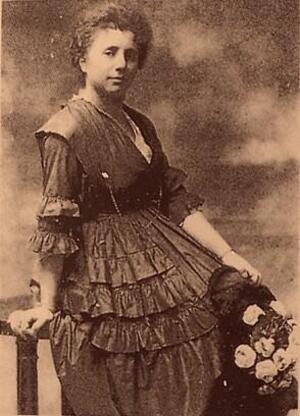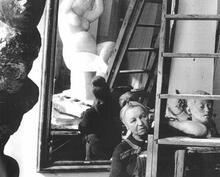Margherita Sarfatti
Born into a wealthy Venetian Jewish family, Margherita Sarfatti joined the Socialist Party and became the art critic for the newspaper Avanti!, where she met Benito Mussolini. The two became lovers, and she followed Mussolini into the Fascist movement and helped plan the rise of the Fascists, including the March on Rome in 1922. Sarfatti converted to Catholicism and defended Mussolini against charges of antisemitism, but she fled in 1938 when Mussolini began passing antisemitic laws.
Early Life
Margherita Sarfatti was born in Venice on April 8, 1880, into the wealthy and cultured Jewish Grassini family. Her father Amedeo was a fiscal attorney for the Venetian government and an intimate friend of the anti-socialist Giuseppe Cardinal Sarto (1835–1914), later Pope Pius X (1903–1914). Like his father, Marco Grassini, he became a Knight of the Crown of Italy. Margherita’s mother was Emma Levi and one of her cousins, Giuseppe Levi (the father of Natalia Ginzburg), eventually became a major proponent of the anti-fascist movement in Turin. Margherita was the fourth and last child in the family. Her sister Colomba (Lina) committed suicide in 1907 after being widowed and her other sister, Nella, perished together with her husband on the way to Auschwitz in 1944. The family lived in an impressive fifteenth-century palazzo on the edge of Venice’s Old Ghetto until 1894, when they moved to the imposing Palazzo Bembo on the Grand Canal.
Sarfatti was educated by private tutors, among them Antonio Fradeletto (1858–1930), the founding director of the Venice Biennale. During her childhood, she began to be interested in art and poetry, influenced by Fradeletto, who introduced her to the theories of John Ruskin. One of her admirers persuaded her to read the works of Karl Marx and other socialist theoreticians, which caused a scandal in her family. In 1898, despite her father’s objections, she married Cesare Sarfatti (1867–1924), a Jewish lawyer from Padua, who was thirteen years her senior and whom she persuaded to join the Socialist Party. During their honeymoon in Paris she made her first purchase of Post-Impressionist art when she bought a set of lithographs and posters by Henri de Toulouse-Lautrec. On October 15, 1902, the couple moved to Milan, where they lived in an apartment situated on Via Brera. At this stage her major interests were the history of art and politics. Later Margherita Sarfatti began to write on feminism and on the most prominent artists of the time. In Milan she was introduced to Gabriele D’Annunzio (1863–1938), an old friend of her husband, met Filippo Turati (1857–1932) and Anna Kulischoff and became an intimate friend of Luigi Majino and his wife Ersilia, the president of the Feminist League of Milan. She gave birth to two sons, Roberto (1900–1918) and Amedeo (b. 1902).
Meeting Il Duce
With the death of her father in 1908, Sarfatti came into a large inheritance, which enabled the family to move to a large apartment on Corso Venezia in Milan and to purchase a country home near Lake Como. In 1909 she began her Wednesday-evening salon, where she entertained the major Italian intellectuals and artists. When the Futurist Movement first appeared, Sarfatti’s salon began to be a regular setting for encounters between Filippo Tommaso Marinetti (1876–1944, the founder of the Futurist movement), Carlo Carrà (1881–1966), Umberto Boccioni (1882–1916), and Luigi Russolo (1885–1947). The Sarfattis spent their holidays at their Como home, Il Soldo (The Penny), where they opened their salon to well-known people such as the poet Ada Negri (1870–1945) as well as to their Milan acquaintances. In 1909 Sarfatti became art critic of the daily newspaper Avanti! and in the same year gave birth to her daughter Fiammetta. In 1912, when Anna Kulischoff started La difesa delle lavoratrici (Women Workers’ Defense), Margherita Sarfatti wrote articles in support of the publication and provided financial support. On December 1, 1912, Mussolini became the manager of Avanti!. A deep friendship between the two soon developed into a love relationship, which was apparently tolerated by Cesare Sarfatti, but not by Rachele Mussolini.
In October and November 1914, Mussolini adopted an interventionist position. He resigned as editor of Avanti!, joined with pro-war leftists outside the Socialist Party and launched a new socialist newspaper, Il Popolo d’Italia (People of Italy). The Socialist Party leadership viewed these acts as a betrayal and expelled him from the party. With the outbreak of World War I Roberto, Sarfatti’s older son, ran off to join the army, although he was underage. Though he was at first sent home, he enlisted legally at the age of seventeen, joining the elite Alpini mountain troops and was sent to the front in July 1917. On January 28, 1918, he was killed in battle while leading an attack on the Austrian front lines and was posthumously awarded Italy’s highest military honor. In 1921 Sarfatti published I vivi e l’ombra, a compilation of elegiac poetry commemorating her son.
At the end of the war, Sarfatti too was expelled from the Socialist Party because of her interventionism. Thereupon she began to work for and collaborate with Popolo d’Italia, the official newspaper of the fascist regime, but also wrote articles for the Turin newspaper La Stampa and for Gerarchia, a revue of political theory edited by Eloisa Foà. After 1922 she became the manager of this revue. Meanwhile she strengthened her liaison with Mussolini. At a public meeting on March 25 in the Piazza San Sepolcro in Rome, Margherita was at Mussolini’s side. Although formally their relationship remained secret, since both were married, Sarfatti began to collaborate in Mussolini’s writing and even prepared the plan of the march on Rome in late October 1922. Indeed, she was so close to Mussolini that she can be described as one of the planners of Fascism.
Fascist Italy
In 1924, when her husband died, Sarfatti moved to Rome, where she held her salon on Friday afternoons. In 1925 she published a personal memoir and biography of Il Duce, The Life of Benito Mussolini, in an English edition. Mondadori published the biography in Italian in 1926 under the title Dux. The book was translated into seventeen languages. In 1925 she was engaged as a vice-president of the Exposition des arts decoratifs in Paris, a task which won her the Legion of Honor. In 1926 she was a theoretician and a leading force of the first exhibition of the Italian Novecento, the opening of which was attended by the Duce himself. In 1927, in Rome, she organized an exhibit of the Dieci artisti del Novecento italiano, in the framework of the Esposizione degli Amatori e Cultori. Towards the end of the 1920s she espoused the evolution of Fascism, with its heroic rhetoric and strict discipline. In the 1930s she openly combined the Novecento movement with the aggressive passion and renewal from which the Fascist Redemptive Action (Opera redentrice del Fascismo) eventually emerged. In 1931 she was often attacked by the revue Regime Fascista but tenaciously sustained the role played by the Novecento group in the diffusion of Italian art abroad. Margherita Sarfatti was one of the protagonists of Italian political and intellectual debate in the age of Giovanni Giolitti (1842–1928).
Towards the end of 1926 Sarfatti moved to Via Rasella in Rome and when Mussolini moved to Villa Torlona in 1928 Margherita Sarfatti, together with her daughter Fiammetta, moved to live in close proximity to the Duce’s residence. That same year she converted to Catholicism. Despite her lover’s anti-Zionist and antisemitic unsigned writings in newspapers and journals she claimed that there was no “Jewish question” in Italy and declared that Mussolini would never follow Hitler’s antisemitic policies. On July 14, 1938, “The Manifesto of the Race” appeared in the Roman daily Il giornale d’Italia. Composed primarily by Mussolini himself, this document condemned the corruption of the Italian Aryan race through intermarriage with Jews.
Sarfatti sensed that, despite her conversion to Catholicism, she was not immune to the antisemitic laws passed in 1938. After her son Amedeo left Italy for Argentina in 1938, Sarfatti followed him, first traveling to Switzerland to deposit Mussolini’s letters in a safe place. In Argentina she continued to be involved in art criticism but did not meet with the same success as she had enjoyed in Italy.
Returning to Italy at the end of 1947, she continued to write, publishing an unapologetic memoir, Acqua Passata, in 1955. She died at her Il Soldo residence on October 30, 1961.
Selected Works
La milizia femminile in Francia. Milan: Ravà, 1915.
I vivi e l’ombra: liriche. Milan: Facci, 1921.
Segni, luci e colori. Bologna: Nicola Zanichelli, 1925.
Dux. Milano: Edizioni Mondadori, 1926..
Il Palazzone: romanzo. Milano: Mondadori, 1929.
Storia della Pittura Moderna. Rome: P. Cremonese, 1930.
Daniele Ronzoni. Rome: 1935.
Acqua Passata. Bologna: Cappelli, 1955..
My Fault: Mussolini as I Knew Him. ed. Brian Sullivan. New York: Enigma Books, 2014.
AA.VV. Da Boccioni a Sironi. Il mondo di Margherita Sarfatti. Milano: Skira, 1997.
Cannistoro, Philip V., and Brian R. Sullivan. Margherita Sarfatti, l’altra donna del Duce (Il Duce’s Other Woman. The Untold Story of Margherita Sarfatti, Mussolini’s Jewish Mistress). Milano: Mondadori, 1993.
Urso, Simona. “La formazione di Margherita Sarfatti e l’adesione al fascismo.” Studi Storici 1 (1994): 153.
Marzorati, Sergio. Margherita Sarfatti: Saggio Biografico. Como: Nodo libri, 1990.
Mann, Vivian. Gardens and Ghettos: The Art of Jewish Life in Italy. Berkeley: University of California Press, 1989.
Formaggio D., Il Novecento Italiano, 1923–1933. Milano: Charta, 1995.




